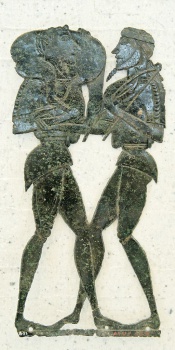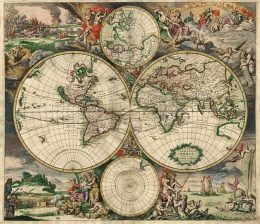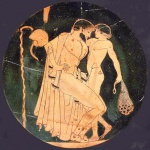Cretan pederasty

Cretan boylove[1] was an archaic form of pederasty[2] that involved the ritual kidnapping or "seizing" (harpagmos) of a noble boy by an adult male of the aristocratic class, with the consent of the boy's father.
The Cretans were a Dorian people described by Plutarch as renowned for their moderation and conservative ways,[3].
The man (known as philetor, "befriender") took the boy (known as kleinos, "glorious") into the wilderness, where they spent several months hunting and feasting with their friends. If the boy was satisfied with the conduct of his would-be comrade, he changed his title from kleinos to parastates ("sidekick," indicating he had fought in battle alongside his lover) [4] returned to the philetor and lived in close bonds of public intimacy with him.[5]
The function of the institution, beside teaching the youth adult skills, was supposed to confirm the status of the best men, and to offer both lover and beloved the chance to give proof of a noble character deserving of respect.[6]
History
| Part of the boylove history series |
 |
| Portal:History |
Archaeological work indicates that the Cretan pederastic tradition was already well established and structured in the Minoan period, around 1650-1500 BCE.[7] Ancient Greek historical tracts trace the origins of the tradition to mythological times. Aristotle states that it was king Minos who established pederasty as a means of population control on the island community: [They] "segregated the women and instituted sexual relations among the males so that women would not have children."[8] The practice seems to have been reserved for the aristocracy, and it was a reciprocal acknowledgment and cultivation of honor. The man was honored by being allowed to take the boy, and the boy's honor was increased by being thus taken. As the historian Strabo records it,
"(The Cretans) have a peculiar custom in regard to love affairs, for they win the objects with their love, not by persuasion, but by abduction; the lover tells the friends of the boy three or four days beforehand that he is going to make the abduction; but for the friends to conceal the boy, or not to let him go forth the appointed road, is indeed a most disgraceful thing, a confession, as it were, that the boy is unworthy to obtain such a lover; and when they meet, if the abductor is the boy’s equal or superior in rank or other respects, the friends pursue him and lay hold of him, though only in a very gentle way, thus satisfying the custom; and after that they cheerfully turn the boy over to him to lead away; if, however, the abductor is unworthy, they take the boy away from him."
Recent scholarship has suggested that the practice may have been adopted by the Dorians around 630 BC, spreading from Crete to Sparta and then to the rest of Greece.[9]
Structure
This custom was highly regarded, and it was considered shameful for a youth to not acquire a male lover. Again, Strabo:
"It is disgraceful for those who are handsome in appearance or descendants of illustrious ancestors to fail to obtain lovers, the presumption being that their character (masculinity) is responsible for such a fate. But the parastathentes (those who stand by their lover in battle) receive honors; for in both the dances and the races they have the positions of highest honor, and are allowed to dress in better clothes than the rest, that is, in the habit given them by their lovers; and not then only, but even after they have grown to manhood, they wear a distinctive dress, which is intended to make known the fact that each wearer has become kleinos, for they call the loved one kleinos (distinguished) and the lover philetor."
Not surprisingly, these same Cretans were credited with introducing the myth of Zeus kidnapping Ganymede to be his lover in Olympus – though even the king of the gods had to make amends to the father.
Strabo also indicates that it is the boy’s masculinity that consigns him his lover:
The most desirable youths, according to Cretan conventions, are not the exceptionally handsome ones, but rather those who are distinguished for manly courage and orderly behavior.
Together the boy and his lover live in the wilderness for a time, and at some point during the courtship the two made an offering of a votive tablet and an animal sacrifice at the sanctuary of Hermes and Aphrodite, on Mt. Dikte, close to the cave where Zeus was said to have been reared.
Upon their return the lover gives the boy expensive gifts, among which a military outfit, an ox (a sacrifice to Zeus), and a drinking cup (symbolic of spiritual accomplishment). At that time, according to Strabo, the boy also is empowered to choose between continuing or putting an end to his relationship with his abductor, and to denounce the man if he misbehaved in any way. Here the cycle of honor given and returned is completed, but now it is the boy's turn to grant - or withhold - that honor:
The youth sacrifices the ox to Zeus and gives a feast to those who came down with him from the mountains. He then declares, concerning his relationship with the lover, whether it took place with his consent or not; the convention encourages this in order that, if any violence is used against him in the abduction, he may restore his honor and break off the relationship.
A late comment by the Roman historian Cornelius Nepos claims that Cretan youths had more than one lover: "Quite young men in Crete are praised for having had as many lovers as they could."[10]
Archeological findings
A number of archaeological findings have been interpreted as documentation of the Cretan pederastic rites. At a rustic shrine dedicated to Hermes and Aphrodite, at Kato Syme, approximately sixty kilometers east of Hagia Triada, on Mt. Dikte (location of the cave where allegedly Zeus was reared) at c. 1200m above sea level, excavations led by Angeliki Lembessi have uncovered numerous bronze objects offered to the deities, together with remains of animal sacrifices.
Among these were found bronze figures of youths from the Minoan period (before 1100 BC), indicating this to have been a long-standing sanctuary site. Such figurines were offered over the course of many centuries. One set, dated to c. 8th-7th century BC and presently in the Louvre depicts a male couple consisting of an older bearded male and a younger male with long, flowing hair and curls in front. The older partner, who carries a horn bow, grasps the younger by the arm and draws him close. The younger carries a slain goat on his shoulders, presumably a sacrificial animal. They are looking intently at each other, their legs and feet touch, and the genitals of the younger male are exposed.
Another bronze piece, dated c. 750 BC and presently in the Heraklion Museum, shows two helmeted but otherwise nude youths, one older than the other. They both display erections and stand beside each other holding hands. Yet another bronze cutout dated to the 7th century BC shows a lad, nude except for a long, decorative cape and sandals, holding a bow and quiver. These pieces document that this Cretan initiatory tradition continued over many centuries and that later offerings left by pairs of lovers at this shrine became more elaborate and erotically explicit.[11]
These objects appear to belong to the same tradition reflected in the Chieftain Cup (image at bottom of linked page), found in 1903 in the male dining club of the palace at Hagia Triada, and dated to the Middle Minoan II to Late Minoan I, (c. 1650 BC-1500 BC). It is carved out of serpentinite and depicts two beardless youths, one older than the other (discernible by the difference in height and in hairstyle), dressed in kilts and tall boots and wearing jewelry. The older presents the younger with a sword and a javelin, while on the reverse of the cup other youths (the lover's friends?) bring three flattened ox hides, presumably for making a shield.[12]
Myths and folktales
Beside the myths, a couple of Cretan pederastic folktales have come down to us, albeit in fragmentary form. In both tales the boy is named Leucocomas (leukos = bright / kóme = hair) and puts his lover to the test by challenging him to perform a number of difficult tasks, known as "athlon" (the same term used of the twelve Labors of Heracles, "dodekathlos"). In the tale of Euxinthetus and Leucocomas the lover must bring the boy's dog from Prasus back to Gortyn, a distance of one hundred eighty stadia (over twenty eight kilometers).[13] In the other tale, that of Promachus ("forward fighter") and Leucocomas, the boy set his lover a number of arduous tasks, culminating in retrieving a priceless helmet. Promachos, however, infuriated by his beloved's endless and unreasonable demands, retrieved the helmet but placed it on the head of another boy, leading Leucocomas to kill himself in a jealous fit.[14]
See also
References
- ↑ Article adapted from Wikipedia
- ↑ Ephorus of Cyme in Strabo's Geography 10.21.4
- ↑ ". . . the manners and rules of life of the Cretans, which were very sober and temperate . . ." Plutarch, Parallel Lives; "Lycurgus"
- ↑ Wilhelm Kroll "Knabenliebe" in Pauly-Wissowa, Realencyclopaedie der klassischen Altertumswissenschaft, vol. 11, cols. 897-906 [1]
- ↑ John Addington Symonds, A Problem in Greek Ethics, X p.14
- ↑ D. B. Dodd, '"Athenian Ideas about Cretan Pederasty," in T. Hubbard (ed.), Greek Love Reconsidered, New York, 2000; pp.33-41
- ↑ Bruce L. Gerig, "Homosexuality in the Ancient Near East, beyond Egypt", in HOMOSEXUALITY AND THE BIBLE, Supplement 11A, 2005
- ↑ Aristotle, Politics, II.10
- ↑ William Armstrong Percy III, "Reconsiderations about Greek Homosexualities," in Same–Sex Desire and Love in Greco-Roman Antiquity and in the Classical Tradition of the West, Binghamton, 2005
- ↑ Cornelius Nepos, Preface, 3-5; trans. Thomas K. Hubbard
- ↑ Bruce L. Gerig, 2005, op.cit.
- ↑ R. KOEHL, “The Chieftain Cup and a Minoan Rite of Passage,” Journal of Hellenic Studies 106 (1986) pp99-110
- ↑ Strabo, Geography X.4.12
- ↑ Conon, Narrations 16.
External links
- Short story available on-line at Academia.edu. Andrew Calimach
